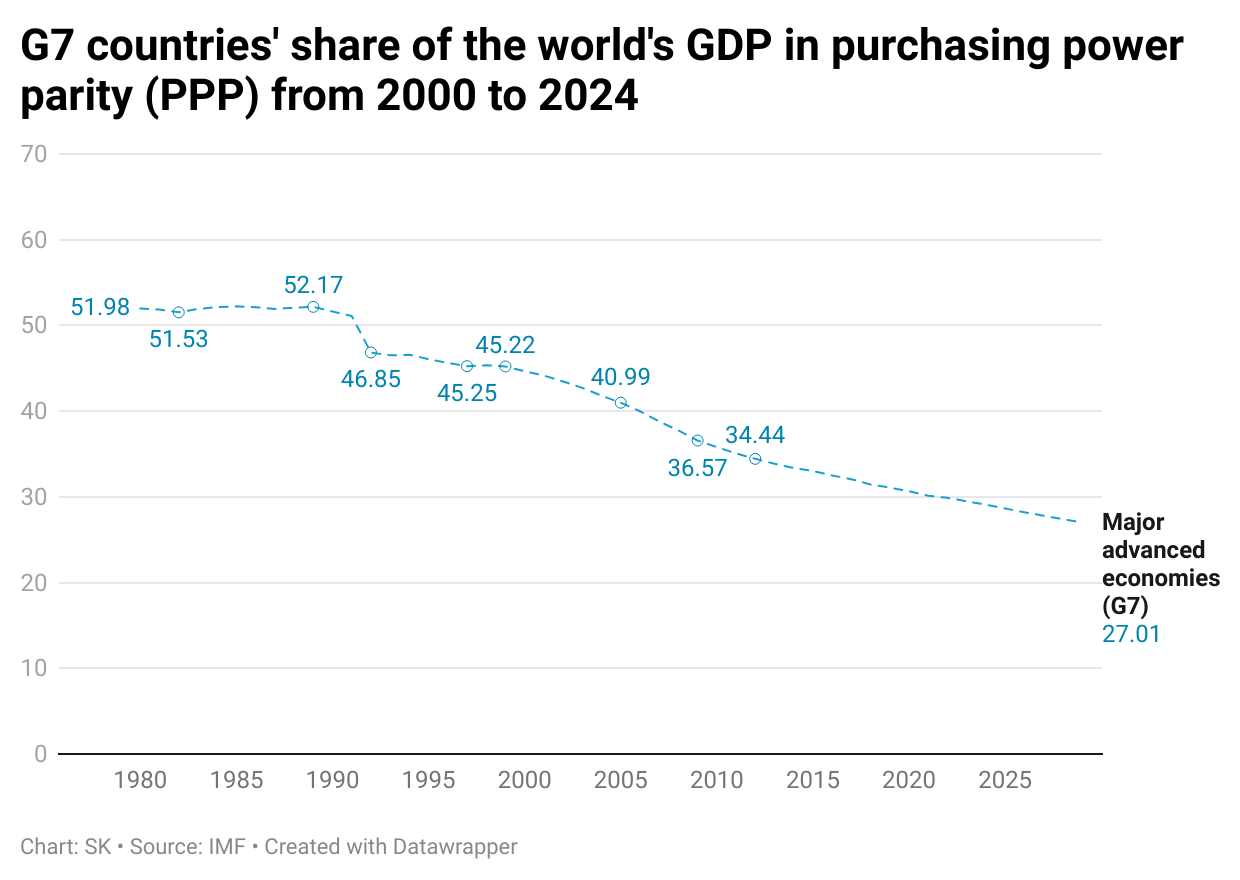G7 vs. BRICS+
The G7 (Group of Seven) and BRICS (Brazil, Russia, India, China, South Africa, and now expanded as BRICS+) represent two significant blocs shaping global economic and political dynamics.
The G7 originated in the early 1970s during a period of global economic instability marked by the first oil crisis and the collapse of the Bretton Woods system. These events prompted informal meetings among finance ministers from major industrialized nations to coordinate economic policies.Today, the members of the G7 include Canada, France, Germany, Italy, Japan, United Kingdom and United States.
The history of BRICS dates back to the early 2000s and has evolved significantly over the years. The term "BRIC" was originally coined by Jim O'Neill, then chief economist at Goldman Sachs, in a 2001 paper titled "Building Better Global Economic BRICs". It was initially an investment concept to describe four emerging economies - Brazil, Russia, India, and China - that were expected to dominate the global economy by 2050.
Here's how they compare:
Economic Power
GDP Share: BRICS countries now account for 35% of global GDP, surpassing the G7's 30%. In terms of purchasing power parity (PPP), BRICS holds 34% of global GDP compared to the G7's 29%..
Trade and Financial Systems: BRICS has developed alternative financial mechanisms like the New Development Bank (NDB) and settlement platforms to reduce reliance on Western-dominated systems such as SWIFT. However, these initiatives have had limited global impact so far.
Population and Representation
Population: BRICS represents 45% of the world's population, compared to just 10% for the G7.
Membership: The G7 includes advanced economies like the US, Japan, and Germany. BRICS+, with recent additions like Egypt, Ethiopia, Iran, and the UAE, reflects a broader coalition of emerging economies. Over 40 countries have expressed interest in joining BRICS- including NATO meber Turkey. In 2024, Iran, Egypt, Ethiopia, and the United Arab Emirates joined BRICS as new member states. Indonesia became the first Southeast Asian member in early 2025.
Environmental Impact
BRICS nations are responsible for approximately 50% of global CO2 emissions, while the G7 contributes about 21%. This highlights a significant environmental challenge for BRICS countries.
Geopolitical Influence
G7: Traditionally seen as a cohesive bloc of advanced democracies aligned with Western interests. However, its influence is waning as its share of global economic power declines.
BRICS: Positioned as a counterweight to Western dominance. While it champions reforms in global governance and South-South cooperation, internal divisions among members (e.g., differing political systems and strategic priorities) limit its coherence and effectiveness.
Challenges
G7
Economic Growth
Slower growth: G7 economies are experiencing slower growth compared to pre-pandemic levels, with the global economy projected to grow at 2.8% in 2025, below the 2010-2019 average of 3.2%.
Uneven performance: Growth prospects vary among G7 members. The US is expected to grow by 1.9% in 2025, while the Euro area is projected to grow by 1.3%.
Declining share
Inflation and Monetary Policy
Disinflation: While inflation is easing in G7 countries, the pace has slowed due to sticky prices in housing and services sectors, as well as tight labor markets.
Policy challenges: Central banks face the task of carefully calibrating monetary policy easing to ensure inflationary pressures are durably contained.
Fiscal Pressures
High public debt: G7 countries are grappling with historically high levels of public debt, which has increased pressure to consolidate public finances.
Spending demands: Governments face mounting public spending demands to address demographic shifts, economic and national security concerns, and climate risks.
Geopolitical Tensions
Trade tensions: Rising trade tensions pose a risk to G7 economies, potentially hampering trade growth and disrupting global supply chains.
Conflicts: Ongoing conflicts and geopolitical tensions, particularly in the Middle East, could disrupt energy markets and impact economic growth.
Structural Challenges
Productivity growth: G7 countries need to boost productivity and address structural issues to enhance long-term growth prospects.
Labor shortages: There is a need to tackle structural increases in labor shortages and enhance education and skills development.
Climate Change and Energy Transition
Investment needs: G7 countries face the challenge of investing in the energy transition while managing fiscal pressures.
Climate risks: Increasing climate-related shocks pose threats to economic stability and food security.
BRICS
The BRICS group faces several key challenges in achieving unity:
Diverging Interests and Priorities
Economic disparities: Members range from high-income nations like the UAE to lower-income countries like Ethiopia, creating tensions between inclusivity and effectiveness.
Different approaches to global engagement: Some members, like China and Russia, push for enhanced integration, while others like India and South Africa are more cautious in balancing relations with BRICS and the West.
Varying priorities: For example, Brazil's focus on environmental issues may clash with the interests of resource-rich nations like Russia.



